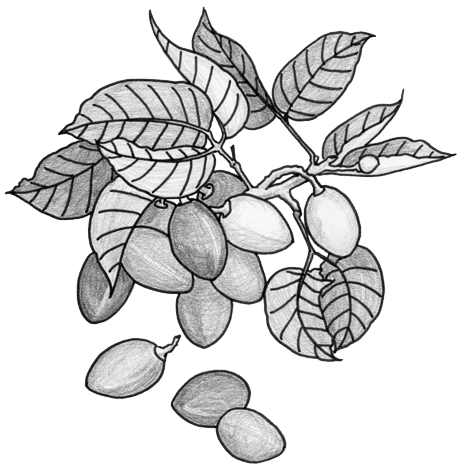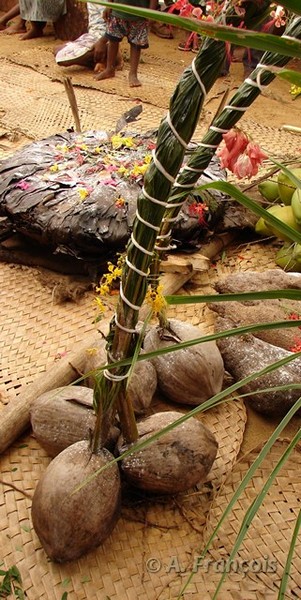n̄ey1 ŋɛj
Cf. Motan̄erewhine, squeak…PNCV*ŋerecry, make noise
Averb, intransitive
Redupn̄eyn̄ey
animal, thingemit a high-pitch and light sound: squeak, squeal; whineanimal, objetémettre un son aigu et faible: couiner; miauler; gémir, geindre
| Vētmahē ni-qōn̄ qiyig e ba kē ni-n̄ey me ēgēn.When it's dark tonight, you'll hear [the gecko] squeak.Quand le soir tombera, tu entendras [le gecko] couiner. |
| Kēy yon̄teg qele kē a n̄eyn̄ey se me!They heard the a moaning sound again.Ils entendirent à nouveau un gémissement. |
| se n̄eyn̄ey[sing squeal] sing with a soprano voice[chanter aigu] chanter soprano |
n̄ey2 °na-n̄ey naŋɛj noun

<°aŋáriPNCV*ʔaŋaʀiPOc*[ka]ŋaʀi
Bot
Pini nut or Java almond (Burseraceae), bsl. NangaeNangaille ou Elemi, sorte d'amande (Burséracées) ; bsl. NangaeCanarium indicum.| nē-glē n̄ey / ni-lig n̄eyalmond tree sapsève de l'amandier |
| ni-sim n̄eyalmond oilhuile d'amande |
nu-qul n̄ey noun
almond lamplamp formerly made with Canarium sap acting as fuellampe d'amandelampe fabriquée autrefois avec de la sève de Canarium en guise de combustible
main entryqul ⓑ▻③
n̄eyda °na-n̄eyda naŋɛjⁿda noun
Flora
one of the two kinds of almond (na-n̄ey)une des deux variétés d'amandes (na-n̄ey)Canarium indicum.📙 Ses fruits se présentent en grappes abondantes
n̄eydi °na-n̄eydi naŋɛjⁿdi noun
Flora
one of the two kinds of almond (na-n̄ey)une des deux variétés d'amandes (na-n̄ey)Canarium indicum.📙 Ses fruits se présentent plutôt isolés
n̄[e]ye1 na-n̄ye naŋjɛ noun
Geography
tip of land stretching into the sea, cape, promontorypointe de terre avancée dans la mer, cap, promontoire
| Kōyō vēy tekel n̄eye en.They made the turning point.Ils franchissent le cap. |
📙 Emploi exceptionnel, sans possesseur, du nom inal. n̄[e]ye~ ②▻⑤.
n̄[e]ye~2 na-n̄ye naŋjɛ noun, relational
Motan̄ere
1sna-n̄yek3sna-n̄yan
Anatomy
1 – hummouth ; esp. outside the mouth (opp. na-ple): lips, lower part of facemuseau, bouchehumbouche ; partic. extérieur de la bouche (opp. na-ple): lèvres, bas du visage
2 – figrarethe mouth as seat of speech ; hence manner of speakingfigrarela bouche en tant que siège de la parole ; d'où façon de parler, caractère
| Na-gatgat to-M̄otlap mal mat le-n̄ye!The Mwotlap language succumbs in your mouth ! (You speak it perfectly)La langue mwotlap succombe dans ta bouche ! (Tu la parles parfaitement) |
| Kē itōk, ba na-n̄yan ne-het, veg kē ni-boboel memeh.She's good at heart, but has a nasty character [lit. her mouth is bad]: she easily loses her temper.Elle a un bon fond, mais elle a un mauvais caractère [litt. sa bouche est mauvaise]: elle se met trop facilement en colère. |
3 – animalmouth, muzzle, beak, billanimalgueule, museau, bec
| Koloyni na-Gop, na-n̄ye en ne-heyhey, ne-mlēmlēg.rhymeMy friend the Heron, your bill is pointed and black.comptineMon ami le Héron, ton bec est pointu et tout noir. |
seen̄[e]yen̄ye~
seen̄‹u›yun̄yu~
4 – metphtip or extremity of a horizontal objectmétphextrémité allongée d'un objet horizontal, pointe
synonymk[e]ye~
n̄[e]yeg ŋɛjɛɣ̞ verb, transitive
Redupn̄[e]yen̄yeg
sell ‹s.th.›vendre
📙 Souvent remplacé par l'emprunt “salem”.
📘 Often replaced with loanword “salem”.
n̄[e]yen̄ye~ na-n̄yen̄ye naŋjɛŋjɛ noun, relational
Redup. n̄[e]ye~
n̄ēh ŋɪh
Motaa-n̄aisaPNCV*ŋaʔisaPOc*ŋaican
Blocative
one day, (if) ever, never: indefinite adverb referring to the future, norm. in hypothetical or temporal protasesun jour, (si) jamais: adverbe indéfini portant sur l'avenir, norm. dans les protases hypothétiques ou temporelles
| Dōyō leg n̄ēh nen en…If ever we get married / If we marry one day...Si jamais nous nous marions / Pour peu qu'un jour nous nous mariions… |
| Kimi lep n̄ēh nē-tlēn e, na-m̄at nan kē to-boel kimi.If ever you steal his eggs, this snake will get angry with you.Si jamais vous lui dérobez ses œufs, ce serpent sera en rage contre vous. |
n̄ēlmet nē-n̄ēlmet nɪŋɪlmɛt noun
Motan̄olmeatthe fringing reef about low water
Ocean
1 – coral reef, bordering the lagoon; partic. upper part of this reef which is visible at low tide (opp. lower part, nē-n̄ēlm̄al)barrière de corail, qui borde le lagon; plus précis. partie supérieure de cette barrière, qui se découvre à marée basse (opp. partie inférieure, nē-n̄ēlm̄al)
2 – metonspace limited by this coral reef: at high tide, the lagoon; at low tide, the coral platformmétonespace délimité par cette barrière de corail: à marée haute, le lagon; à marée basse, le platier corallien
| Nok so van kaykay gantēl mōmō susu a lē-n̄ēlmet, ne-met ma-mah !I'll go and get some small fish out of the lagoon, because it's low tide.Je vais nous pêcher quelques petits poissons dans le lagon, car c'est la marée basse. |
n̄i ni-n̄i niŋinɪŋɪ
nē-n̄ē
noun
Flora
assembled objects, gen. plants, attached either naturally (bunch, cluster) or artifically (bundle, bunch)assemblage d'objets, gén. végétaux, attachés ensemble soit naturellement (grappe) soit artificiellement (ballot, fagot)
| ni-n̄i gayga[bundle of ropes]ligature [paquet de cordes] |
ni-n̄i mitig noun
inflorescence of the coconut tree, in cluster forminflorescence du cocotier, sous forme de grappe
| Nō-wōlēlē ni-mwoy, tō ni-n̄i mitig ni-kalō.The bract splits, allowing the coconut's inflorescence to emerge.La bractée se fend, et laisse sortir l'inflorescence du cocotier. |
ni-n̄i m̄el noun
cluster of young coconuts (m̄el_2)grappe de jeunes noix de coco (m̄el_2)
| Kōmyō van bah tot te n̄i m̄el!Go and pick me a bunch of young coconuts!Allez donc me cueillir une grappe de jeunes cocos! |
ni-n̄i wōh
nē-n̄ē wōh
noun

bunch, bundle of several green coconuts (nō-wōh) tied together (nuyteg) with their own fibresballot constitué de plusieurs noix de coco vertes (nō-wōh) nouées ensemble (nuyteg) par leurs propres fibres
| Gēn lep nu-qul motow, nē-n̄ē wōh, mōk tiwag mi na-tgop, wēl na-lqōvēn aē.You take a bunch of germinated coconuts and a bundle of young coconuts, that you add to the laplap ; and this is how you buy a wife.On prend une botte de cocos germés et un ballot de cocos jeunes, que l'on ajoute au laplap ; et c'est ainsi que l'on achète une femme. |
EthnologieCes ballots font partie des présents offerts par la famille de l'homme à celle de la femme, le jour du mariage (Cf. leg). Ils sont généralement associés à des cocos germés attachés par leur tige (nu-qul motow)
ni-n̄i motow
nē-n̄ē motow
noun

bundle of several germinated coconuts (na-mtow) tied together by their stemsballot constitué de plusieurs noix de coco germées (na-mtow) attachées ensemble par leurs tiges
| Kēy goh yak ni-pni motow, tō lēg tiwag, so galeg nē-n̄ē motow.You tear off (a piece of) coconut husk, then you tie them together to make a bundle.On arrache (un morceau de) l'écorce des cocos, puis on les attache ensemble, pour en faire un ballot. |
synonymnu-qul motow
n̄‹i›li~ ni-n̄li niŋli noun, relational
Motan̄oli-utop shoot of a plantPNCV*ŋoli
top shoot of a plant
| ni-n̄li qey... |
n̄it ŋit verb, transitive
Redupn̄itn̄it
1 – bite, with one's teethmordre, avec les dents
| Na-bago mi-n̄it mat kē.He was bitten by a shark.Il a été mordu à mort par un requin. |
3 – s.o.nibble, bite ‹s.o.›, esp. a woman biting a man during lovemaking. Evokes physical pleasure and, by metonymy, feeling between two loversqqnmordiller, faire une morsure à ‹qqn›, partic. d'une femme à un homme au cours de l'acte amoureux. Évoque le plaisir physique, et par méton. le sentiment d'amour entre deux amants
n̄oyhey no-n̄oyhey nɔŋɔjhɛj noun
Motan̄orasere
Fish
sharp beakreef fish, with a long pointed snoutbec pointupoisson récifal, au museau pointu
n̄‹u›yun̄yu~ nu-n̄yun̄yu nuŋjuŋju
nu-gyugyu~
noun, relational
3sgnu-n̄yun̄yu-n3sgnō-n̄yōn̄yō-n
snout, nosecochongroin, nez
| nu-n̄yun̄yu qopig nosegroin de cochon |
nu-n̄yun̄yu qo noun
Fish
pigpig noseBlack sweetlips, bsl. Tiklips: reef fish, 50 cmgroin de cochonLoche casteix, poisson récifalPlectorhynchus gibbosus.